Wales

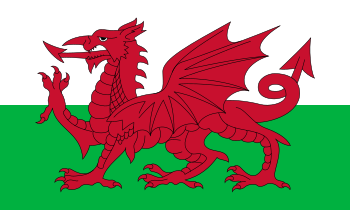
Wales (Welsh: Cymru) is a mountainous land on the west of Great Britain, with the Irish Sea to the west and north, the Celtic Sea to the south and the English Midlands to the East.
Wales is distinct geographically and culturally, which facts are related and both fed by its history, for Wales represents the mountain fastness into which the Britons and their culture retreated when faced with the incoming tide of the ancestral English. These mountains preserved the ancient British language, known today as Welsh, and a mountain farming culture quite unlike the ways of the flat Midlands to the east.
The thirteen counties of Wales (including Monmouthshire) together make up 8,023 square miles, with a population of three million. It has 746 miles of coastline and several offshore islands, none large except for the Isle of Anglesey, the largest island in the Irish Sea, and Holy Island its neighbour.
The shape of the land
The counties of Wales are:
- Anglesey
- Brecknockshire
- Caernarfonshire
- Cardiganshire
- Carmarthenshire
- Denbighshire
- Flintshire
- Glamorgan
- Merionethshire
- Montgomeryshire
- Pembrokeshire
- Radnorshire
- Monmouthshire — generally included as part of Wales, although throughout its history it has been treated as part of England for some forms of administration and parts of Wales for others.
Wales is generally mountainous: the only county with no land over a thousand feet is Anglesey. The highest mountains though look over that island, in the north and central areas, especially in Snowdonia, which contains Snowdon as its highest peak, and at 3,560 feet Snowdon is the highest ground in all of Britain south of the Highlands of Scotland.
Wales has a changeable, maritime climate making it one of the wettest places in the European region. Due to the hilly landscape, pastoral farming has always dominated agriculture, but industrialisation burst upon much of Wales in the 18th century; mining, slate quarrying and the related industries transformed much of Glamorgan, Monmouthshire and Caernarfonshire into industrial heartlands, though the latter shire has subsided somewhat since. Industrialisation also transformed the social structure; Glamorgan and Monmouthshire now hold two-thirds of the population of Wales mainly in and around the cities of Cardiff, Swansea and Newport and in the nearby valleys, most descended from those who poured into those counties from across the United Kingdom to work in the new industries. Accordingly the Welsh language has declined also since those days, becoming a minority language in most of Wales.
Cardiff is the most populous city in Wales, counted at 317,500 residents in 2001, and for a period it was the biggest coal port in the world. Today, with the traditional heavy industries of coal, steel, copper, tinplate and slate either gone or in decline, the economy depends on the public sector, light and service industries, and tourism.
Culture and language


The Welsh language is the original British language, reckoned to be so little changed over the centuries that a farmer of today would be able to understand a farmer of the Dark Ages if ever they could meet and converse, and so it is part of the essence of British culture and identity. Though the language is spoken by just a minority today, the vast majority of place-names in Wales, and a great many in Shropshire, Worcestershire and Herefordshire, are of the Welsh language. Bilingualism is taken to such an extent that every public road sign in Wales is bilingual, even in areas where Welsh has not been spoken for centuries.
Over 580,000 Welsh speakers live in Wales; more than 20% of the population. The language was once believed to be in terminal decline, but this triggered a movement for revival. Victorian romanticism created the Eisteddfod, now the Royal National Eisteddfod of Wales, which seeks to uphold the ancient bardic tradition by awards for poetry in the ancient tongue, all carried out with great ceremonial, with "druids" and "bards". Today Welsh is now a compulsory part of primary education throughout Wales and official bilingualism has made the language
From the late 19th century onwards, Wales acquired its popular image as the "land of song", attributable in part to the revival of the eisteddfod tradition. This idea has long roots though: Gerald of Wales noted that part-singing was a feature of Wales, and after the Revival of the eighteenth and nineteenth centuries, non-conformist chapels spread across the land with rousing popular hymn-singing in their services.
Overall, Wales shares the same culture as the rest of the United Kingdom, but the language and the legacy it has left even where it is not spoken are a distinct and cherished cultural marker.
Names of Wales
The name "Wales" is from Old English; Wealh meant "foreigner" and Wealas "foreigners". From this too is Wylisc or Wielisc for "Welsh", for at the time of their coming into the island the native Britons were foreigners to them. The place-name element wal- in England, as in "Walton", is believed to come for the most part from the presence of a village of Britons remaining in English territory. The same Germanic root is found in the way the German-speaking Swiss label French and Italian speakers as welsch and in names such as "Wallonia" and "Wallachia".
In early English texts the men of Wales were Norþwealas, as opposed to the Westwealas of Cornwall. Time and the impact of the Viking invasions brought the English and Welsh together in common purpose, but the names had by then been long established.
In the Welsh language, Wales is known as Cymru and its people as Cymry. The Welsh language likewise is Cymraeg. This name Cymry is derived from the Old Welsh Cumbrogi, apparently a rendering in the British tongue of the Latin civis ("citizens" or "our own people") to distinguish the Britons from the incoming Saxons. The same words have given a name to the Cambrian Mountains and to Cumberland, once the Welsh land of the north.
The word Combrogi came into use as a self-description probably before the 7th century.[1] It is attested in a praise poem to Cadwallon ap Cadfan (Moliant Cadwallon, by Afan Ferddig) c. 633.[2] In Welsh literature, the word Cymry was used throughout the Middle Ages to describe the Welsh, though the older, more generic term Brythoniaid continued to be used to describe any of the Britonnic peoples (including the Welsh) and was the more common literary term until c. 1100. Thereafter Cymry prevailed as a reference to the Welsh. Until c. 1560 Cymry was used indiscriminately to mean either the people or their homeland.[3]
The Welsh for England is Lloegr (or in earlier texts Lloegyr) which may once have referred to the Kingdom of Mercia, but which came to refer to England as a whole. The origin of the word is unknown.
History
There are a great many prehistoric remains found in Wales, describing life of the Mesolithic to the Iron Ages, which all fall within the general pattern of the history of Great Britain. History specific to these lands and the Welsh culture however must begin with the Romans.
Roman era
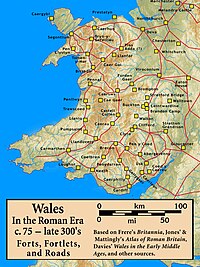
By the time of the Roman invasion of Britain, the area of what we now know as Wales had been divided among the tribes of the Deceangli, Ordovices, Cornovii, Demetae and Silures for centuries. The Roman conquest of the mountains began in AD 48 and took 30 years to complete, in the face of fierce native resistance taking advantage of the terrain. Only in the southern coastal region of Monmouthshire and Glamorgan was there is a legacy of Romanisation.[4] The only town in Wales founded by the Romans, Caerwent, is in Monmouthshire. Both Caerwent and Carmarthen, in Carmarthenshire also in southern Wales, became Roman civitates.[5] The Romans mined the mountains, using their advances engineering skills to extract large amounts of gold, copper and lead, and modest amounts of some other metals such as zinc and silver.[6] Romanisation was far from complete in Britannia; Latin was the official language but throughout the island the people continued to speak British and only the upper classes were in a position to assume the advantages Roman identity.

Early historians, including the 6th century cleric Gildas, have noted 383 as a significant point in Welsh history,[7] as it is stated in literature as the foundation point of several mediæval royal dynasties. In that year according to local tradition the Roman general Magnus Maximus, (Macsen Wledig in the Mabinogion), stripped western and northern Britain of troops and senior administrators to pursue his bid for power, which was partially successful as he was hailed as Emperor in Britain and Gaul until his ultimate defeat.[8][9] Gildas, writing in about 540, says that Maximus left Britain taking not only all of its legions, but also with all of its armed bands, governors, and the flower of its youth, never to return. Having taken Roman administration away but planning to continue as the ruler of Britain in the future, Magnus Maximus transferred authority to local rulers.
Tradition states that Magnus Maximus brought a prince named Cynedda from the north to rule what became north-western Wales and defend it from Irish attacks, and the Kings of Gwynedd and neighbouring kingdoms claimed descent from Cynedda. The earliest Welsh genealogies give Maximus the role of founding father for several royal dynasties, including those of Powys and Gwent.[10][11] It was this transfer of power that has given rise to the belief that he was the father of the Welsh Nation.[7] He is given as the ancestor of a Welsh king on the Pillar of Eliseg, erected nearly 500 years after he left Britain, and he figures in lists of the Fifteen Tribes of Wales.[12]
Sub-Roman Britain
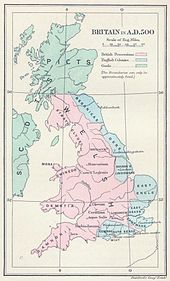
Wales as such did not exist until a couple of centuries after the collapse of Roman rule, conventionally dated to 410, but the ground was prepared in those years. It would not be stretching words too far to say that at the end of the Roman occupation Wales was all Britain, for Roman Britannia was of the same nation and language, and even in the twelfth century Gerald of Wales reported that Welshmen saw England still as the lost land which the Welsh would regain one day when their past sinfulness had been forgiven.
From the fifth century much of the lowlands of Britain to the east and south-east were overrun by various Germanic tribes. The area held by the English flowed and ebbed in battle and of this time we have such legends as that of King Arthur and in the north the historically attested Urien of Rheged. By Gildas's time in around 540 an "unhappy partition with the barbarians" had been established, but soon afterwards the peace broke down and the English swept west, driving the Britons to the mountains. The survival of the Britons in the western kingdoms was to become the foundation of what we now know as Wales. The last of the Midlands were lost to the English in the seventh century and the distinctive area now known as Wales was established.
Wales was not united but divided into kingdoms often at war with one another and often on a king's death the kingdom was divided between his sons, which led to instability and conquest. The most powerful kingdoms were Powys, Gwent and Gwynedd.
The birth of Wales
The ninth century revolutionised the relationships between the kingdoms of Britain. Invasions by the pagan Vikings gave a common cause to the Christian kingdoms of the Welsh and English. In 853 the Vikings raided Anglesey and the Christians of Wales and England had common cause. In 856 Rhodri Mawr (Rhodri the Great) defeated and killed the Danish leader, Gorm,[13] but later Anarawd ap Rhodri allied with the Norsemen occupying Northumbria.[14] Before long this alliance broke down and Anarawd came to an agreement with Alfred of Wessex and accepted his overlordship. According to Annales Cambriae, in 894, "Anarawd came with the Angles and laid waste Ceredigion and Ystrad Tywi."[15] Howell the Good united Wales as one kingdom and ended hostility to the English; inspired by King Alfred's laws he created the first Welsh law code and even named one of his sons Edwin.

From 800 onwards, a series of dynastic marriages allowed Rhodri the Great (844–77) to inherit Gwynedd and Powys. His kingdom was divided on his death and his sons founded three principal dynasties (Aberffraw in Gwynedd, Dinefwr in Deheubarth, and Mathrafal in Powys). Rhodri's grandson Hywel the Good (900–50) founded the kingdom of Deheubarth out of his maternal and paternal inheritances of Dyfed and Seisyllwg in 930, and expelled the Aberffraw dynasty from Gwynedd and Powys. He codified Welsh law in the 940s on the English pattern.[16] Maredudd ab Owain of Deheubarth (986–99) (Hywel's grandson) would again temporarily oust the Aberffraw line from control of Gwynedd and Powys.
Gruffydd ap Llywelyn was the first and only Welsh king to rule all Wales. He was Maredudd's great-grandson (through his daughter Princess Angharad) and ruled from 1039 to 1063; he conquered his cousins' realms from his base in Powys.[17] However Gruffydd's expansion into England brought Harold Godwinsson down upon him; from land and sea Harold overran all Wales.
The Middle Ages
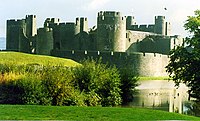
Within four years of the Battle of Hastings England had been completely subjugated by the Normans and William the Conqueror was swift to ensure the ancient allegiance of the Welsh princes.[17] William gave estates to his most powerful lords along the Welsh border with autonomous authority to expand their territories westwards,[18] and in this manner was Wales to be subdued piecemeal. The Norman lordships in Wales became known as the Welsh Marches, and the Marcher Lords were subject neither to English nor Welsh law.[19] The area of the March varied as the fortunes of the Marcher Lords and the Welsh princes ebbed and flowed.[20]
Owain Gwynedd (1100–70) of the Aberffraw line was the first Welsh ruler to use the title princeps Wallensium (prince of the Welsh), according to John Davies.[21] His grandson, Llywelyn Fawr (the Great, 1173–1240), wrested concessions out of the Magna Carta in 1215 and receiving the fealty of other Welsh lords in 1216 at the council at Aberdovey, became the first Prince of Wales.[22] His grandson Llywelyn ap Gruffydd received the title Prince of Wales from Henry III in 1267,[23] but a succession of disputes, including the imprisonment of Llywelyn's wife Eleanor, daughter of the rebel Simon de Montfort, culminated in the an invasion by King Edward I of England in 1277. In 1282 war broke out again and King Edward at last put an end at the rule of the Welsh princes. Llywelyn died in battle and his head was carried through London on a spear. His brother was executed for treason and Llywelyn's daughter Gwenllian was sent away to the priory at Sempringham, where she remained until her death 54 years later.[24]

To help maintain his command, Edward constructed a series of great stone castles. Beaumaris, Caernarfon and Conway. His son, the future King Edward II, was born at Edward's new castle at Caernarfon in 1284.[25] He became the first English Prince of Wales. The apocryphal story is that Edward offered the Welsh a Welsh-born Prince who could speak no English, and then presented his new-born son, and an addition says that he proclaimed him as "Eich dyn" ("Your man"), but this story was first recorded in 1584,[26] and Edward II became Prince of Wales not as an infant, but in 1301, while the motto "Ich Dien" may be from a latter prince's adventures in Germany. The north-western part of Wales was ruled by the Prince and known as the Principality of Wales, which provided an income, while the rest of Wales was the March.
The end of Llywelyn seemed to be the end of a thousand years of warfare in Wales; wars between Welsh princes, wars or inheritance and wars between Welsh princes and English marcher lords. A short revolt broke out in 1294–95 led by Madog ap Llywelyn, but the peace descended until England was convulsed; the overthrow of Richard II in 1399 triggered an uprising against the usurper Henry IV, led by Owain Glyndŵr. In 1404, Owain was reputedly crowned Prince of Wales in the presence of emissaries from France, Spain and Scotland.[27] Glyndŵr went on to hold parliamentary assemblies at several Welsh towns, including Machynlleth. The rebellion was ultimately to founder, however, and Owain went into hiding in 1412, with peace essentially restored in Wales by 1415. Thereafter the wards played out across the Welsh castles were those of the Wars of the Roses that convulsed the whole island until the accession of Henry VII, a Welshman, to the English throne.
Modern period
In 1536 under King Henry VIII, the Laws in Wales Act 1535 took effect, and the Welsh Marches were abolished after over 450 years. Wales was no longer subject to the whims of feudal lords but was annexed to England and represented in Parliament. All the laws of Wales, largely left unreformed for centuries, were swept away to be replaced by English law. Wales at last had equality as part of England.

The eighteenth century revolutionised Welsh society; the Revival swept the hills, led by John Wesley and the Methodists, though several other non-conformist denominations were building their chapels in the villages and drawing ever-growing congregations. Soon too the Industrial Revolution broke upon the mining areas of Glamorgan, Monmouthshire, Anglesey and Caernarfonshire, creating rapid economic expansion between 1750 and 1850. It began with the development of copper smelting in the Swansea area using local coal and Cornish copper, but in Anglesey the largest copper mine in the world at was opened at Parys Mountain. Iron, copper and soon coal fuelled the growth; in the 1820s, south Wales alone accounted for 40% of all pig iron manufactured in Britain.[28]
Caernarfonshire's mountains roofed the world with slate and the Glamorgan's valleys produced its coal. The slow decline in slate quarrying in the late twentieth century left Caernarfonshire to revert to pasture and to the enjoyment of its natural beauty. The sudden collapse of the coal industry had a more dramatic effect of the mining villages of the South Wales valleys.
Geography and natural history

Wales is a generally mountainous. It is about 170 miles north–south and 60 miles east–west. The oft-quoted 'size of Wales' is about 8,023 square miles. Wales is bordered by England to the east (Cheshire, Shropshire, Herefordshire and Gloucestershire) and by sea in all other directions: the Irish Sea to the north and west, St George's Channel and the Atlantic Ocean to the southwest and the Bristol Channel to the south.
Altogether, Wales has over 733 miles of coastline.[29] Over 50 islands lie off the Welsh mainland; the largest being Anglesey, in the northwest.
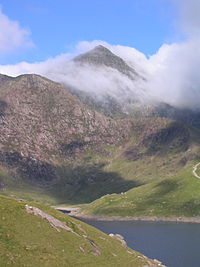
Much of Wales' diverse landscape is mountainous, particularly in the north and central regions. The mountains were shaped during the last ice age, the Devensian glaciation. The highest mountains in Wales are in Snowdonia, of which five are over 3,281 feet, the highest of these being Snowdon at 3,560 feet). The 15 Welsh mountains over 3,000 feet high are known collectively as the Welsh 3000s and are all located in a small area in Caernarfonshire.[30]
The Brecon Beacons are in the south (of which the highest point is Pen-y-Fan, at 2,907 feet). Adjoining are the Cambrian Mountains in Mid Wales, of which the highest point is Plynlimon at 2,467 feet.

Wales has three national parks:
- Snowdonia
- Brecon Beacons and
- Pembrokeshire Coast
It has five "Areas of Outstanding Natural Beauty", which include Anglesey, the Clwydian Range, the Gower Peninsula and the Wye Valley. The Gower Peninsula was the first area in the United Kingdom to be so designated, in 1956. Forty two percent of the coastline of South and West Wales is designated as Heritage Coast, with 13 specific designated strips of coastline maintained by the Countryside Council of Wales.[31]
The south and west coasts of Wales, along with the Irish and Cornish coasts, are frequently blasted by Atlantic westerlies and south westerlies that, over the years, have sunk and wrecked many vessels. On the night of 25 October 1859, over 110 ships were destroyed off the coast of Wales when a hurricane blew in from the Atlantic.[32] More than 800 lives were lost across Britain due to the storm but the greatest tragedy was the sinking of the Royal Charter off the coast of Anglesey in which 459 people died.[33] The number of shipwrecks around the coast of Wales reached a peak in the 19th century with over 100 craft losses and an average loss of life of about 78 sailors a year.[34] Wartime action caused losses near Holyhead, Milford Haven and Swansea.[34] Due to offshore rocks and unlit islands, Anglesey and Pembrokeshire are still notorious for shipwrecks, such as the Sea Empress Disaster in 1996.[35]

Mythology
The remnants of the native Celtic mythology of the pre-Christian Britons was passed down orally, in much altered form, by the cynfeirdd (the early poets).[36] Some of their work survives in much later mediæval Welsh manuscripts, known as: the Black Book of Carmarthen and the Book of Aneirin (both 13th century) and the White Book of Rhydderch (14th century); and the Red Book of Hergest (c. 1400).[36]
The prose stories from the White and Red Books are known as the Mabinogion, a title given to them by their first translator, Lady Charlotte Guest.[37] Poems such as Cad Goddeu (The Battle of the Trees) and mnemonic list-texts like the Welsh Triads and the Thirteen Treasures of the Island of Britain, also contain mythological material.[38][39][40] These texts include the earliest forms of the Arthurian legend and the traditional history of post-Roman Britain.[36]
Other sources of Welsh folklore include the 9th century Latin historical compilation Historia Britonum (the History of the Britons) by Nennius and Geoffrey of Monmouth's bizarre (or satirical) 12th century Latin chronicle Historia Regum Britanniae (the History of the Kings of Britain).
The style of the early folklore, in particular that of the Mabinigion, has suggested themes for later storytellers, who may draw from such sources an idea of an authentic "Celtic" theme in their mixture of magic and warriorhood.
Outside links
- BBC Wales
- VisitWales.com The official international guide to places to stay and things to do in Wales.
- VisitWales.co.uk The official UK guide to places to stay and things to do in Wales.
- Wales – Official Gateway to Wales
- Gathering the Jewels – Welsh Heritage and Culture
- Photographs of Wales
References
- ↑ Phillimore, Egerton (1891). "Note (a) to The Settlement of Brittany". in Phillimore, Egerton. Y Cymmrodor. XI. London: Honourable Society of Cymmrodorion. 1892. pp. 97–101. http://books.google.com/books?id=M35QO0vor-EC&pg=PA97.
- ↑ Davies (1994) p. 71, The poem contains the line: 'Ar wynep Kymry Cadwallawn was'.
- ↑ John Davis, A History of Wales, p69
- ↑ Jones, Barri; Mattingly, David (1990). "The Development of the Provinces". An Atlas of Roman Britain. Cambridge: Blackwell Publishers (published 2007). p. 151. ISBN 9781842170670.
- ↑ Jones, Barri; Mattingly, David (1990). "The Development of the Provinces". An Atlas of Roman Britain. Cambridge: Blackwell Publishers (published 2007). p. 154. ISBN 9781842170670.
- ↑ Jones, Barri; Mattingly, David (1990). "The Economy". An Atlas of Roman Britain. Cambridge: Blackwell Publishers (published 2007). pp. 179–196. ISBN 9781842170670.
- ↑ 7.0 7.1 Davies (2008) p.531
- ↑ Frere, Sheppard Sunderland (1987). "The End of Roman Britain". Britannia: A History of Roman Britain (3rd, revised ed.). London: Routledge & Kegan Paul. p. 354. ISBN 0-7102-1215-1.
- ↑ Giles, John Allen, ed (1841). "The Works of Gildas, The History, Ch. 14". The Works of Gildas and Nennius. London: James Bohn. p. 13. http://books.google.com/books?id=3R1mCE7p44MC&pg=PA1.
- ↑ Phillimore, Egerton, ed (1887). "Pedigrees from Jesus College MS. 20". Y Cymmrodor. VIII. Honourable Society of Cymmrodorion. pp. 83–92. http://books.google.com/books?id=HlUrAAAAIAAJ&pg=PA83.
- ↑ Phillimore, Egerton (1888). "The Annales Cambriae and Old Welsh Genealogies, from Harleian MS. 3859". in Phillimore, Egerton. Y Cymmrodor. IX. Honourable Society of Cymmrodorion. pp. 141–183. http://books.google.com/books?id=aFMrAAAAIAAJ&pg=PA141.
- ↑ Rachel Bromwich, editor and translator. Trioedd Ynys Prydein: The Welsh Triads. Cardiff: University of Wales Press, Third Edition, 2006. 441–444
- ↑ Davies (2008) p. 911
- ↑ Charles-Edwards, T M (2001). "Wales and Mercia, 613–918". in Brown, Michelle P; Farr, Carol Ann. Mercia: an Anglo-Saxon kingdom in Europe. Leicester University Press. p. 104. ISBN 0718502310.
- ↑ Hill, David (2001). "Wales and Mercia, 613–918". in Brown, Michelle P; Farr, Carol Ann. Mercia: an Anglo-Saxon kingdom in Europe. Leicester University Press. p. 176. ISBN 0718502310.
- ↑ Davies (2008) p. 388
- ↑ 17.0 17.1 John Davis (1994) p. 100. He states that Gruffydd was "the only Welsh king ever to rule over the entire territory of Wales... Thus, from about 1057 until his death in 1063, the whole of Wales recognised the kingship of Gruffudd ap Llywelyn. For about seven brief years, Wales was one, under one ruler, a feat with neither precedent nor successor." Davies
- ↑ Davies (1994) p. 101
- ↑ Max Lieberman (2010). The Medieval March of Wales: The Creation and Perception of a Frontier, 1066–1283. Cambridge: Cambridge University Press. p. 6. ISBN 052 176 978 7. http://books.google.com/?id=2nda0A3pVYAC&pg=PA19. Retrieved 4 October 2010.
- ↑ "Chapter 6: The Coming of the Normans". BBC Cymru Wales website. BBC Cymru Wales. 2008. http://www.bbc.co.uk/wales/history/sites/themes/guide/ch6_coming_of_the_normans.shtml. Retrieved 4 October 2010.
- ↑ Davies (1994) p. 128
- ↑ Davies (1994) pp. 133–134
- ↑ Davies (1994) pp. 143–144
- ↑ "Tribute to lost Welsh princess". BBC News. 12 June 2000. http://news.bbc.co.uk/2/hi/uk_news/wales/786625.stm. Retrieved 5 March 2007.
- ↑ Davies (1994) p. 162
- ↑ Davies (1994) p. 175
- ↑ Davies (1994) p. 194
- ↑ Davies, p 393
- ↑ "The Official Yearbook of Great Britain and Northern Ireland". Office for National Statistics. The Stationary Office. 30 April 2010. http://www.statistics.gov.uk/downloads/theme_compendia/UK2002/UK2002.pdf.
- ↑ "The Welsh 3000s Challenge". welsh3000s.co.uk. http://www.welsh3000s.co.uk/. Retrieved 28 September 2010.
- ↑ "Heritage Coasts". britainexpress.com. http://www.britainexpress.com/countryside/coast/. Retrieved 29 September 2010.
- ↑ Davies (2008) p.778
- ↑ "Stormy Weather". BBC North West Wales website. BBC. 28 April 2006. http://www.bbc.co.uk/wales/northwest/sites/history/pages/tomparryllandudnopier.shtml. Retrieved 26 September 2010.
- ↑ 34.0 34.1 Davies (2008) p.814
- ↑ "In detail: The Sea Empress disaster". BBC News website (BBC). 2000. http://news.bbc.co.uk/1/shared/spl/hi/picture_gallery/06/uk_the_sea_empress_disaster/html/1.stm. Retrieved 26 September 2010.
- ↑ 36.0 36.1 36.2 Snyder, Christopher Allen (2003). The Britons. Wiley-Blackwell. pp. 258–261. ISBN 063122260X. http://books.google.com/books?id=QI_-cR_nZYsC&pg=PA258. Retrieved 26 November 2010.
- ↑ Davies (2008) p. 525
- ↑ Ford, Patrick K (2008). The Mabinogi and Other Medieval Welsh Tales (2nd ed.). Berkley and Los Angeles: University of California Press. p. 183. ISBN 9780520253964. http://books.google.com/books?id=DeaGo-Qkf2kC&pg=PA183. Retrieved 26 November 2010.
- ↑ Koch, John Thomas (2006). Celtic culture: a historical encyclopedia. Santa Barbara: ABC-CLIO. pp. 359 & 1324. ISBN 1 85109 440 7. http://books.google.com/books?id=f899xH_quaMC&pg=PA1324. Retrieved 26 November 2010.
- ↑ White, Donna R (1998). A century of Welsh myth in children's literature. Westport, CT: Greenwood Publishing Group. p. 123. ISBN 0313305706. http://books.google.com/books?id=yDVykkOOP6QC&pg=PA123. Retrieved 26 November 2010.
Books
- Davies, John (1994). A History of Wales. London: Penguin. ISBN 0-14-01-4581-8.
- Template:Cite encylopedia